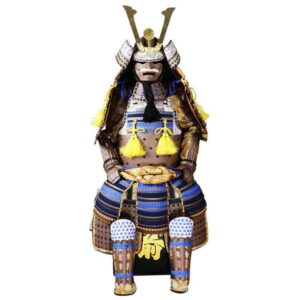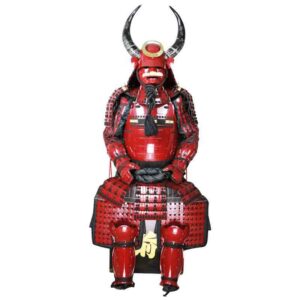Description
Step into the world of ancient Japan with this exquisite Golden Takeda Clan Japanese Samurai Armor. Crafted with meticulous attention to detail, this armor set is not just a piece of protective gear but a symbol of honor, tradition, and the warrior spirit. Each component of this armor is handcrafted by skilled armor smiths, following traditional methods to ensure authenticity and quality.
Features:
- Full-sized and fully functional armor set, suitable for display and wear.
- Display size: 67 x 30 x 30 inches, designed to fit individuals between 5.5 and 6.0 feet tall with an average body type.
- Made from high-quality materials, including cold rolled steel, lacquer, cotton, hemp, and silk.
- The armor set includes a helmet (Kabuto), face mask (Menpo), shoulder guard (Sode), chest plate (Do), sleeve (Kote), gloves (Yaguke), belt & sash (Uwa & Obi), skirt (Kusazuri), thigh guard (Haidate), and shin guard (Suneate).
- Features intricate details and traditional paint variations.
- Custom-made to fit the wearer well, maximizing mobility and speed while maintaining protection.
- Comes with a black lacquered display storage box and display stand for convenient display.
Specifications:
- Material: Cold rolled steel, lacquer, cotton, hemp, silk
- Craftsmanship: Half handmade, half mechanical
- Paint: 180° environmentally friendly spray
- Configuration: Armor set + armor stand + armor box




Historical Background:
The Takeda clan is one of the most storied samurai families in Japanese history, known for their remarkable military prowess and influence during the Sengoku period (1467-1600). Originating from the Kai province, now part of modern-day Yamanashi Prefecture, the Takeda clan established themselves as formidable warriors and strategic masterminds.
Rise to Power:
The Takeda clan’s rise to power began under the leadership of Takeda Nobutora, but it was his son, Takeda Shingen, who elevated the clan to its greatest heights. Born as Takeda Harunobu in 1521, Shingen changed his name in 1551 when he took the tonsure and became a Buddhist monk, a common practice for samurai leaders to signify a new phase in their life. Shingen’s name means “Faithful Heart,” reflecting his deep commitment to the principles of Buddhism and his warrior code.
Shingen’s military career is marked by his innovative tactics and strategic brilliance. He transformed his cavalry into a powerful force known for its devastating charges, a tactic that earned his army the nickname “Kiba Gundan” (Mounted Army). His leadership during the Battles of Kawanakajima against Uesugi Kenshin is legendary. These battles, fought over a period of several years, are considered some of the most iconic and tactically intriguing confrontations of the Sengoku period. The fourth battle of Kawanakajima in 1561 is particularly famous for the intensity of the combat and the strategic maneuvers employed by both sides.
Takeda Shingen’s Innovations:
Shingen was not just a military tactician but also a visionary leader who implemented several administrative reforms in his domain. He introduced a legal code known as the “Takeda Law,” which streamlined governance and justice in his territories. His economic policies, such as promoting agriculture and improving infrastructure, contributed to the prosperity and stability of his province.
Shingen’s strategic genius is exemplified by his adoption of the famous battle standard “Fūrinkazan,” which translates to “Wind, Forest, Fire, Mountain.” This phrase, derived from Sun Tzu’s “The Art of War,” encapsulated Shingen’s approach to warfare: swift as the wind, silent as the forest, fierce as fire, and immovable as a mountain. These principles guided his military campaigns and helped solidify his reputation as one of Japan’s greatest samurai generals.
Decline and Fall:
The decline of the Takeda clan began with the death of Takeda Shingen in 1573. His son and successor, Takeda Katsuyori, faced significant challenges in maintaining the clan’s dominance. Katsuyori’s leadership was marked by a series of military defeats, the most significant being the Battle of Nagashino in 1575. This battle was pivotal as the combined forces of Oda Nobunaga and Tokugawa Ieyasu employed innovative tactics, including the use of firearms, to decimate the Takeda cavalry.
The loss at Nagashino marked the beginning of the end for the Takeda clan. Internal strife, defections, and relentless pressure from rival clans further weakened their position. In 1582, the combined forces of Oda Nobunaga and Tokugawa Ieyasu launched a decisive campaign against the Takeda. This campaign culminated in the fall of the Takeda stronghold and the eventual death of Katsuyori, effectively ending the clan’s power.
Legacy:
Despite their downfall, the Takeda clan’s legacy endured. The principles and strategies developed by Takeda Shingen influenced future generations of samurai and military leaders. The clan’s history is celebrated in Japanese culture, with countless books, dramas, and historical studies dedicated to their exploits. Takeda Shingen, in particular, is revered as one of the finest military leaders in Japanese history, embodying the spirit of the samurai warrior.
The Takeda clan’s impact on Japanese history is profound, serving as a symbol of strategic acumen, warrior ethics, and the tumultuous yet fascinating era of the Sengoku period. Their story continues to inspire and captivate those who study the samurai and their indomitable spirit.
















Reviews
There are no reviews yet.